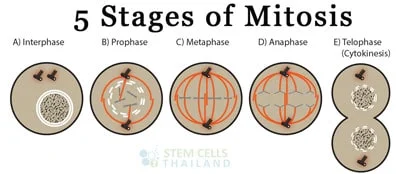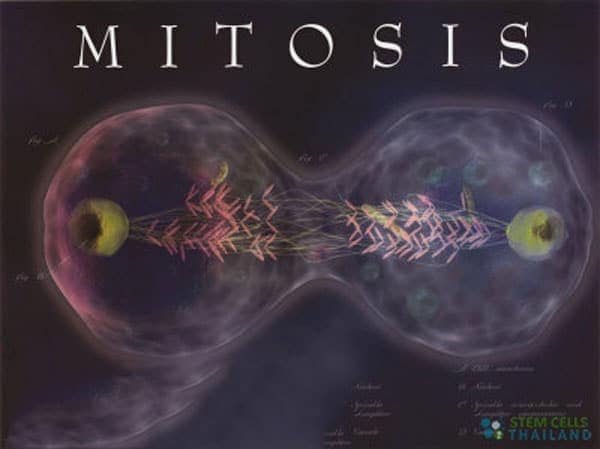All cells have to eventually duplicate. in nature, there are 2 main methods of cell duplication. Mitosis and Meiosis.
The Process of Mitosis
Mitosis is the exact opposite of cell duplication through meiosis where the chromosome population is split in half. [1] This fundamental process of cell division allows for each new cell to retain their original chromosome numbers, allowing other cell types to increase or maintain its populations. Mitosis and the process known as cytokinesis define the “M” mitotic phase of the cell division cycle. In this process, the mother cell will form into two distinct daughter cells.[2]
Mitosis is the process by which a single eukaryotic cell divides to produce two daughter cells, each containing an identical set of chromosomes. This is crucial for growth, development, and tissue repair in multicellular organisms. Mitosis ensures that each daughter cell receives a full set of chromosomes, preserving the genetic information of the parent cell.
5 stages of mitosis

Prophase:
- Chromatin Condensation: The long, thread-like chromatin condenses and becomes visible under a light microscope as individual chromosomes. Each chromosome consists of two sister chromatids held together at a region called the centromere.
- Nuclear Envelope Breakdown: The nuclear envelope begins to disintegrate.
- Spindle Formation: The mitotic spindle, a structure made of microtubules, begins to form. Centrosomes, which are the cell’s microtubule-organizing centers, move to opposite poles of the cell and help in spindle formation.
Metaphase:
- Chromosome Alignment: The chromosomes align at the equatorial plane, known as the metaphase plate, in the center of the cell. This ensures that each daughter cell will receive one chromatid from each chromosome.
- Spindle Attachment: The spindle fibers attach to the centromere of each chromosome.
Anaphase:
- Sister Chromatid Separation: The centromeres split, and the sister chromatids are pulled apart towards the opposite poles of the cell. This separation ensures each daughter cell will have a full set of chromosomes.
- Cell Elongation: The cell elongates due to the lengthening of the microtubules.
Telophase:
- Nuclear Envelope Reformation: The nuclear envelope re-forms around each set of separated sister chromatids.
- Chromosomes De-condense: The chromosomes begin to de-condense back into the thread-like chromatin.
- Nucleoli Reappear: The nucleoli, regions within the nucleus where ribosomal RNA is produced and assembled, start to become visible again.
Cytokinesis:
While not technically a phase of mitosis, cytokinesis usually occurs shortly after mitosis. It involves the division of the cytoplasm, resulting in the formation of two separate daughter cells. In animal cells, this is achieved through the formation of a cleavage furrow, which pinches the cell into two. In plant cells, a cell plate forms in the middle and eventually develops into a new cell wall, dividing the cell into two.
It’s important to note that mitosis is just one part of the cell cycle. Before entering mitosis, cells go through a phase called interphase, which includes G1 (gap 1), S (synthesis, where DNA is replicated), and G2 (gap 2) phases. Interphase is a period of growth and preparation for the cell to undergo mitosis.
When the cells duplicate through mitosis, two identical cells are formed in the gastrulation process.[3]There are five basic phases in the life-cycle of all cells. The Phases are known as PMATI (pronounced PeeMahtEee). The 5 phases of mitosis are:
More on Cytokinesis & Telophase
The process of Mitosis ends with telophase which is the point that our chromosomes reach the poles. After this stage, the nuclear membrane begins to reforms, and chromosomes start to decondense into the interphase conformation. The telophase stage is followed by cytokinesis, which is the division of the cytoplasm into 2 daughter cells. Daughter cells which are formed in this process have identical compositions genetically.
Published Clinical Citations
[1] ^ Boettcher, Barbara, and Yves Barral. 2013. The cell biology of open and closed mitosis. Nucleus (Austin, Tex.), no. 3 (April 15). doi:10.4161/nucl.24676. https://www.ncbi.nlm.nih.gov/pubmed/23644379
[2] ^ Heijink, Anne Margriet, Małgorzata Krajewska, and Marcel A T M van Vugt. 2013. The DNA damage response during mitosis. Mutation research, no. 1-2 (July 21). doi:10.1016/j.mrfmmm.2013.07.003. https://www.ncbi.nlm.nih.gov/pubmed/23880065
[3] ^ Kuffer, Christian, Anastasia Yurievna Kuznetsova, and Zuzana Storchová. 2013. Abnormal mitosis triggers p53-dependent cell cycle arrest in human tetraploid cells. Chromosoma, no. 4 (April 28). doi:10.1007/s00412-013-0414-0. https://www.ncbi.nlm.nih.gov/pubmed/23624524

